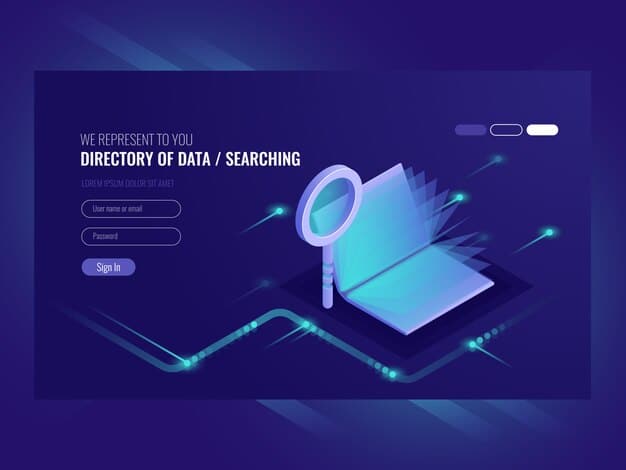Unveiling Bias in Book Reviews: 2025 Critical Reading Guide

Navigating the intricate landscape of book reviews requires a discerning eye, as inherent biases, whether conscious or unconscious, consistently shape perceptions and influence reader choices, necessitating a critical reading approach for authentic literary engagement.
Ever wondered if that glowing five-star review truly reflects a book’s merit, or if it hides something more? Understanding the Bias in Book Reviews: A 2025 Guide to Critical Reading is essential in today’s saturated literary market. It invites you to peel back the layers of subjectivity and uncover the nuanced influences at play.
The Evolving Landscape of Book Reviews in 2025
The world of book reviews has transformed dramatically. What once was the domain of professional critics in esteemed publications now encompasses a vast, often chaotic, ecosystem of opinions. From Goodreads to TikTok’s #BookTok, voices are amplified, democratizing literary discourse but also introducing new layers of complexity.
This evolution means that understanding the origins and potential biases of a review is more crucial than ever. The sheer volume of content necessitates a sharper critical lens for readers to discern genuine insights from mere noise or promotional fluff.
The Shift from Traditional to Digital Gatekeepers
In the past, major newspapers and literary magazines held significant sway over public perception. Their critics, often highly educated and well-versed in literary theory, served as cultural gatekeepers. Their reviews, though sometimes polarizing, were generally seen as authoritative. Today, the landscape is fragmented.
- Democratization of Voice: Anyone with an internet connection can publish a review.
- Algorithmic Influence: Platforms use algorithms to highlight reviews, sometimes based on engagement rather than quality.
- Short-form Content: The rise of platforms like TikTok favors brevity, potentially sacrificing depth for virality.
This shift paradoxically empowers readers while making their job harder. The abundance of information doesn’t always equate to clarity. Instead, it often requires a more sophisticated approach to filtering and evaluating the deluge of opinions.
Identifying Subtleties of Author and Publisher Bias
Bias isn’t always overt; often, it’s woven into the fabric of the literary ecosystem itself. Authors, publishers, and even the review platforms themselves can introduce subtle biases that color a reader’s perception. Recognizing these underlying influences is a cornerstone of critical reading.
Authors, understandably, want their work to be well-received. They might engage in practices that, while not strictly unethical, can subtly influence reviews. Publishers, aiming for commercial success, employ various marketing tactics that often extend into the review space.
The Advance Reader’s Copy (ARC) Economy
Publishers frequently distribute Advanced Reader’s Copies (ARCs) or Galleys to reviewers, influencers, and critics long before a book’s official release. The goal is to generate early buzz and secure reviews. While a common practice, it can inadvertently create an echo chamber.
- Sense of Obligation: Reviewers might feel a subtle pressure to be positive, especially if they wish to receive future ARCs.
- Limited Perspective: Early reviews often come from a relatively small, self-selected group, potentially lacking diverse viewpoints.
- Pre-publication Hype: ARCs contribute to a narrative of anticipation that can overinflate expectations for a forthcoming title.
Furthermore, authors sometimes engage directly with reviewers, fostering relationships that, while benign, could blur the lines of objectivity. A personal connection, however slight, can sway a review’s tone or content. This isn’t to say all ARC reviews are biased, but rather that the context of their creation warrants consideration.
Reviewer Biases: Personal Preferences and Professional Conflicts

At the heart of many biased reviews lies the human element: the reviewer. Every individual brings their unique worldview, experiences, tastes, and even professional obligations into their evaluation. These factors can create a spectrum of biases, from unconscious leanings to more deliberate conflicts of interest.
Understanding these biases isn’t about dismissing a review entirely, but rather about contextualizing it. A review isn’t a universally objective truth but a subjective interpretation filtered through a person’s specific lens.
The Unconscious Subjectivity and Echo Chambers
Even the most well-intentioned reviewer possesses unconscious biases. These can stem from personal preferences for certain genres, writing styles, themes, or even character types. A reviewer who exclusively reads fantasy might struggle to objectively evaluate a literary fiction novel, simply because it doesn’t align with their usual reading habits.
- Genre Preference: Strong affinity for a specific genre can lead to overly harsh or overly lenient reviews outside that genre.
- Authorial Voice: Reviewers might prefer or dislike particular authorial styles, regardless of the book’s overall quality.
- Personal Experience: A reviewer’s life experiences can color their interpretation of characters or plot points, leading to skewed assessments.
Moreover, online communities can create echo chambers where similar opinions are reinforced. Reviewers within these groups might subconsciously conform to prevailing sentiments, leading to a homogeneity of opinion that masks individual critical thought. This social conformation can be particularly strong in niche communities.
Professional Biases and Financial Incentives
Beyond personal preferences, professional relationships and financial incentives introduce another layer of potential bias. Book bloggers, influencers, and even traditional critics might receive compensation for their work, directly or indirectly. This doesn’t automatically negate their reviews but demands transparency.
An influencer paid by a publisher to promote a book, for example, is unlikely to post a negative review. While disclosures are often required, readers must remain vigilant about the underlying motivations. Similarly, professional critics might feel pressure to maintain relationships with publishing houses for continued access to ARCs or interview opportunities.
The rise of sponsored content blurs the lines between genuine review and paid endorsement. Distinguishing between them requires careful attention to disclosure statements and a critical evaluation of the review’s tone and substance. Is it overwhelmingly positive without specific, actionable insights? Does it read more like an advertisement than an analysis?
Algorithmic and Platform Biases in Review Aggregation
In 2025, algorithms play an increasingly dominant role in how we discover and engage with content, and book reviews are no exception. Platforms like Goodreads, Amazon, and even social media sites use complex algorithms to sort, display, and even influence the visibility of reviews. These algorithms, while designed to enhance user experience, are not neutral; they carry inherent biases that can profoundly impact the perception of a book.
Understanding how these digital gatekeepers operate is essential for a comprehensive critical reading approach. The way reviews are presented to you can be as influential as the content of the reviews themselves.
The Filter Bubble Effect on Review Exposure
Algorithms are designed to show you what they think you want to see. This often means prioritizing content that aligns with your past engagement, demographic data, and stated preferences. While this can be convenient, it can also create a “filter bubble” around book reviews.
- Reinforcing Existing Views: You might predominantly see reviews that confirm your pre-existing opinions or tastes.
- Limiting Exposure: Reviews offering dissenting or alternative viewpoints may be less likely to appear in your feed.
- Exaggerating Popularity: Algorithms can amplify books that are already trending, creating an illusion of universal appeal.
This filtering can lead to a skewed perception of a book’s overall reception. A book might have a diversity of opinions, but if the algorithm only shows you positive or negative ones, your understanding becomes incomplete. It’s crucial to actively seek out varied perspectives to break free from these algorithmic limitations.
Review Manipulation and Gatekeeping Mechanisms
Unfortunately, some biases are less about algorithmic preference and more about direct manipulation. Review platforms grapple with issues like fake reviews, review bombing, and coordinated efforts to inflate or deflate ratings. These malicious activities directly undermine the integrity of the review system.
Furthermore, platforms themselves can act as gatekeepers through their moderation policies. While designed to combat spam and abuse, these policies can sometimes inadvertently suppress legitimate critical opinions or favor certain types of content. For instance, a platform might inadvertently de-prioritize lengthy, nuanced reviews in favor of shorter, more easily consumable soundbites.
The transparency of these algorithmic and moderation practices is often limited, making it challenging for the average reader to fully grasp their impact. Therefore, relying solely on aggregated star ratings or top reviews without deeper scrutiny can be misleading. A critical reader in 2025 must remain aware that the digital stage for reviews is not always a level playing field.
Strategies for Critical Reading of Book Reviews in 2025

To navigate the complex world of book reviews in 2025, a proactive and strategic approach to critical reading is indispensable. It’s not enough to simply consume reviews; one must actively interrogate them, seeking depth and context beyond the surface-level assessment. Developing these skills empowers you to make informed decisions about your reading choices.
The goal isn’t to dismiss all reviews, but to learn how to discern which ones offer genuine value and which are influenced by biases that might not align with your own interests or critical standards.
Look Beyond the Star Rating
Star ratings are convenient, but they are often the most deceptive element of a review. A high star rating doesn’t automatically mean a book is universally good, nor does a low one imply it’s universally bad. The substance of the review is far more important.
- Read the Full Text: Don’t just glance at the stars. Dive into the written content to understand the reviewer’s reasoning.
- Identify Specifics: Does the review offer concrete examples from the book (e.g., plot points, character development, writing style) to support its claims?
- Assess Coherence: Does the reviewer’s overall argument hold together? Are their points logical and well-articulated?
Often, a nuanced two-star review that explains its criticisms thoughtfully can be more informative than a generic five-star review simply stating, “Loved it!” Look for reviews that tell you *why* a reviewer felt the way they did, rather than just *what* they felt.
Diversify Your Review Sources
Relying on a single source or a handful of similar reviewers can limit your perspective. To counteract algorithmic echo chambers and personal preferences, actively seek out a wide range of opinions. This means exploring different platforms, different types of reviewers, and even different critical approaches.
Consider the following types of sources:
- Professional Critics: Still valuable for their literary background and often rigorous analysis.
- Expert Bloggers/Influencers: Those who specialize in a niche might offer unparalleled depth within that genre.
- General Readers: Insights from everyday readers can offer perspectives on relatability and genuine enjoyment, free from academic jargon.
- International Reviews: If available, reviews from different cultural contexts can offer fresh and enlightening viewpoints.
Actively searching for reviews that challenge your initial impressions or that offer a contrarian viewpoint can be incredibly beneficial. It’s about building a holistic picture of a book’s reception rather than accepting the first opinion you encounter.
Future-Proofing Your Critical Reading Skills for 2025 and Beyond
As the digital literary landscape continues to evolve, so too must our critical reading skills. The challenges of bias, both human and algorithmic, are unlikely to diminish. Instead, they may become more sophisticated, demanding an even sharper, more adaptable approach from readers. Future-proofing your ability to critically assess book reviews means embracing continuous learning and maintaining a healthy skepticism.
This isn’t about becoming a cynic, but rather about becoming an informed and empowered reader who can confidently navigate the vast sea of literary opinions.
Embracing Media Literacy and Digital Nuance
The future of critical reading is intertwined with broader media literacy. Understanding how information is produced, disseminated, and consumed online is crucial. This includes recognizing the business models behind review platforms, the role of social media in shaping discourse, and the pervasive nature of personalized algorithms.
- Questioning Sources: Consistently ask “who created this review and why?” and “what is their agenda?”
- Recognizing Patterns: Learn to spot recurring themes in biased reviews, whether it’s excessive praise or unfounded criticism.
- Staying Informed: Keep up with discussions around AI-generated content, deepfakes, and other emerging technologies that could impact review authenticity.
Developing a critical digital eye means not just evaluating the content of a review but also its context within the wider digital ecosystem. This holistic view provides a more robust defense against various forms of bias.
Developing Your Own Internal Compass
Ultimately, the most powerful tool against bias in book reviews is your own fully developed critical faculty. While external reviews are valuable input, they should never replace your own engagement with a text. Read reviews, consider their points, but always form your own opinion based on your personal reading experience.
Cultivating your internal compass involves:
- Self-Awareness of Bias: Understand your own reading preferences and potential blind spots. Are you drawn to certain genres? Do you consistently dislike certain tropes? Recognizing your own biases helps you account for them.
- Active Reading Practices: Engage deeply with the text itself. Underline, take notes, and reflect on your immediate reactions before consulting reviews.
- Trusting Your Instincts: If a highly acclaimed book doesn’t resonate with you, it’s okay. Your personal connection to literature is valid, even if it diverges from popular opinion.
In a world overflowing with opinions, the ability to read critically, form your own judgments, and truly connect with literature on your terms is the most valuable skill you can possess. By understanding bias, you don’t diminish the value of reviews; instead, you enhance your ability to leverage them wisely while preserving your own unique literary journey.
| Key Point | Brief Description |
|---|---|
| 📚 Evolving Landscape | Reviews shifted from traditional critics to diverse digital platforms, demanding sharper critical skills. |
| 🔍 Reviewer Bias | Personal tastes, professional ties, and unconscious leanings influence review content. |
| 🤖 Algorithmic Impact | Platform algorithms can create filter bubbles and influence review visibility. |
| 💡 Critical Strategies | Go beyond stars, diversify sources, and trust your own reading judgment. |
Frequently Asked Questions About Review Bias
Understanding bias helps readers make more informed decisions, distinguishing genuine literary critique from mere marketing hype or personal preferences. It ensures a richer and more authentic engagement with books, preventing undue influence on reading choices and fostering independent thought in navigating the vast literary landscape.
Yes, publishers can influence reviews through various means, such as distributing Advanced Reader’s Copies (ARCs) which may create a sense of obligation, sponsoring content from influencers, or employing marketing strategies designed to generate positive buzz. While not always unethical, these practices can subtly sway critical reception.
Algorithms on platforms like Amazon or Goodreads prioritize reviews based on engagement or user’s past preferences, creating “filter bubbles.” This can limit exposure to diverse opinions, reinforcing existing views and potentially amplifying certain books unfairly, thus skewing the aggregate perception of a title’s quality or popularity.
Beyond the star rating, read the entire review to grasp its specifics and reasoning. Look for concrete examples from the book mentioned. Also, consider the reviewer’s background and potential vested interests, and compare the review with others from diverse sources to get a balanced perspective.
Protecting yourself involves diversifying review sources, scrutinizing unusually zealous or vague reviews, and developing a personal critical lens. Be wary of reviews lacking specific detail or those that read purely as promotional material. Trust your own judgment after reading the book, rather than solely relying on external opinions.
Conclusion
In a world brimming with literary choices and digital discourse, mastering the art of critically reading book reviews is more than a mere skill; it’s a necessity. From understanding the unconscious leanings of a reviewer to recognizing the subtle influences of algorithms and publishers, every layer of bias informs our perception. By adopting a discerning mindset – looking past star ratings, diversifying our review sources, and cultivating our own robust critical compass – we empower ourselves. This approach doesn’t diminish the value of reviews but rather transforms them into valuable tools, allowing us to truly engage with literature on our own terms, making informed and authentic reading choices in 2025 and beyond.





